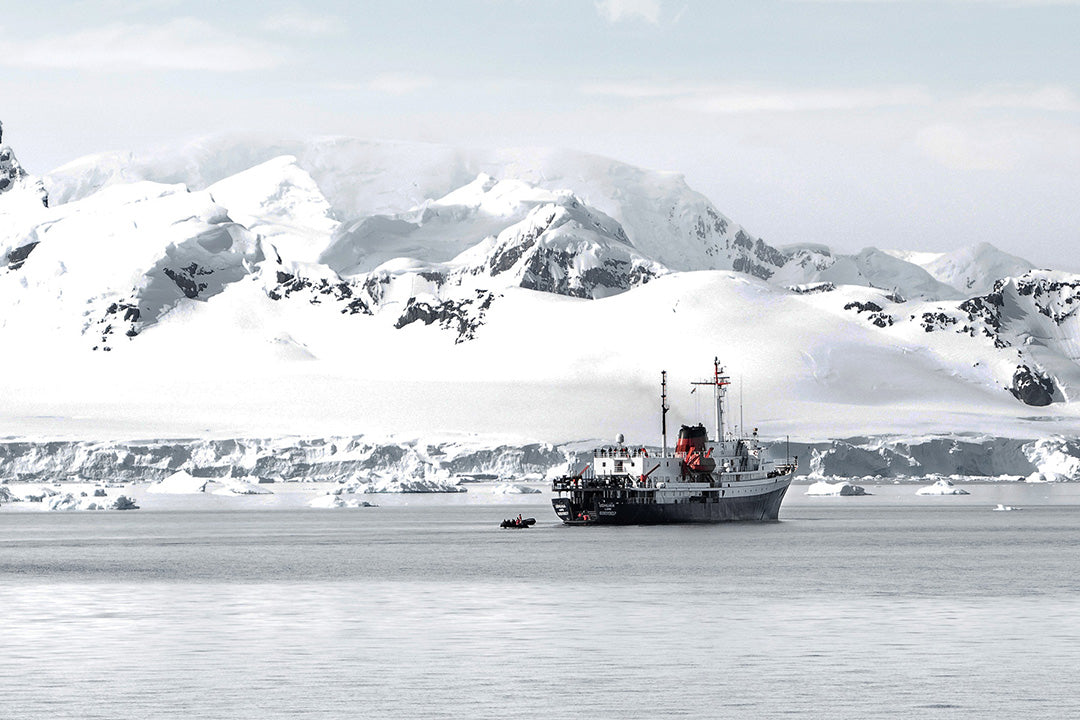Top 10 travel tips for reaching Antarctica
March 4, 2024

So you’ve been traveling with your vacation time for a while now and knocked most of the world’s continents off your list and the time has come to invest in reaching the final frontier. More than likely, Antarctica is next on your list. Having just returned from an expedition, here’s what we wish we knew going in.
1. Pack Puffy
You’re not going to need outfits on your travels to the end of the earth, but you are going to need lots of layers of the down-filled variety. Here’s the list of layers we actually used on the voyage:
-Plane clothes for to and from Ushuaia
-Boat clothes for the ship (and closed toe shoes with good grip for decks)
-At least 4 pairs of wool socks
-Wool base layer for top and bottom
-Fleece layer for top and bottom
-Down layer for top and bottom (if you don’t have down pants, now is the time to get them)
-Waterproof layer for top, bottom, and gloves (Montbell makes gortex glove covers)
-Hats, gloves, neck gator, sunglasses/ski goggles

2. Pack Light
Number two on the list and we’re already double-dipping… but this is important. You will likely fly into Ushuaia, Argentina and there will probably be multiple flights, countries, and customs lines to stand in along the way. Even if you’re checking a bag, you’ll be reunited with your baggage at multiple points as you transfer countries. Then, you have hotel and boat transfers to navigate after that! You’re going to have your hands full, no doubt. Bring only what you need, and try to fit it into 1-2 bags that you can easily carry.
We opted for a GlobeRider45 and an Advanced Series Freefly Duffle. The combination was great. We used Flatpak Drybags to compress our down layers and kept them all together in the duffle bag so that it was extra-light to carry alongside our Globerider.

3. Prepare to get rocked
Once you’re on a boat, you’ll set sail to cross the Drake Passage. The weather and water are unpredictable, and this passage is often regarded as the roughest seas in the world. There will be lots of Dramamine packets on the boat, but there are prescription motion-sickness options available if you’re the type of person that experiences nausea. We recommend asking your primary care and coming prepared.

4. Pick an expedition agency that suits the kind of trip you want.
There are ships of all sorts and sizes heading to Antarctica, ranging from sailboats to full on cruise ships in size. We opted for and enjoyed a small ice-breaking ship that was big enough to have a comfortable journey but small enough for a personalized experience. The agency we used was Polar Latitudes, and we recommend them as a good option for adventurous types that still like some creature comforts (like Starlink and a sauna) while aboard. There are options out there for every type of traveler.
5. Ditch the extra shoes or hiking boots, you won’t need them (unless told otherwise).
To access land in Antarctica, you’ll have to put on big rubber boots that are often provided. You’ll sanitize the boots before hopping from the ship to a small Zodiac boat, and sanitize again upon re-boarding the main ship after each landing. We brought our own hiking boots, but were required to use the provided rubber boots. This is common practice, because you’ll usually climb off the zodiac into knee deep waves and proper sanitization is needed to protect the ecosystem. Save the space in your bag if your ship provides boots!

6. The best time to visit Antarctica is Summer in the southern hemisphere (Winter in the northern hemisphere.)
Temperatures and conditions will vary, widely. However, we experienced between 30 and 40 degrees Fahrenheit on most days that we did landings. The other surprising thing that comes with summer in Antarctica is that it will be light out most of the night. An eyemask is a good addition to your travel kit, especially if you sign up for a night or two of camping on the mainland (which, we do recommend).
7. Bring a real camera in addition to your phone- and put it in a drybag or Camera Base Layer while you ride in the zodiac boat to the landing sites.
There are a lot of trips where a full-on dedicated camera might be a bit extra- but this isn’t one of them. Antarctica is beautiful, and there’s lots of time to get photos. The hikes are very short, and you don’t need to carry much ashore. The potential for bright light conditions and white reflective snow can also be very challenging for cell phone cameras to capture. As we were doing product photography, we had equipment with us. Ultimately, we were very glad to have it.

8. Being a well-traveled and worldly human is an investment.
Visiting Antarctica is expensive for many people as compared to traveling other places. There’s not a lot of opportunities for cutting cost, because the access options are so few. If seeing the world is important to you and you anticipate wanting to visit Antarctica within a few years- start saving for it specifically. Is it worth the investment? Well, it totally depends on the individual. It may not be everyone, but if you want to do it then we recommend saving up for it. Value is in the eye of the beholder.
9. It’s not the beach, but you will need your sunblock.
Pretty straightforward… the sun is strong and ground is reflective. Bring some high quality face sunscreen of your choice. We shared ours with a lot of folks that were not prepared.

10. Chill- you’re going to see plenty of penguins.
Bring binoculars for wildlife viewing if you would like, we enjoyed having them on the boat. If you’re like us, you might excitedly start scouring the shorelines for penguins immediately. But take our word for it and just… chill out! You’re going to see a lot of penguins, in very close proximity (we’re talking within feet of you) In retrospect, we could have relaxed a bit more on the sailing journey and we would have still seen hundreds and hundreds of penguins of all varieties.
That’s pretty much all the tips we have for making your visit to Antarctica a fun one. Enjoy some of the images below from our journey. If you want more information, we traveled with Next Meridian and their YouTube episode of the expedition is full of information on the trip itself.



0 comments